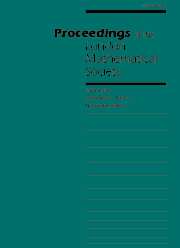Crossref Citations
This article has been cited by the following publications. This list is generated based on data provided by
Crossref.
Pierce, Lillian B
2006.
A bound for the 3-part of class numbers of quadratic fields by means of the square sieve.
Forum Mathematicum,
Vol. 18,
Issue. 4,
Baker, Roger
2009.
Numbers in a given set with (or without) a large prime factor.
The Ramanujan Journal,
Vol. 20,
Issue. 3,
p.
275.
Гриценко, Сергей Александрович
Gritsenko, Sergey Alexandrovich
Карацуба, Екатерина Анатольевна
Karatsuba, Ekatherina Anatol'evna
Королeв, Максим Александрович
Korolev, Maxim Aleksandrovich
Резвякова, Ирина Сергеевна
Rezvyakova, Irina Sergeevna
Толев, Дойчин Иванов
Tolev, Dojchin Ivanov
Чанга, Марис Евгеньевич
and
Changa, Maris Evgen'evich
2012.
Научные достижения Анатолия Алексеевича Карацубы.
Современные проблемы математики,
Vol. 16,
Issue. ,
p.
7.
Narkiewicz, Władysław
2012.
Rational Number Theory in the 20th Century.
p.
131.
Changa, M. E.
Gritsenko, S. A.
Karatsuba, E. A.
Korolev, M. A.
Rezvyakova, I. S.
and
Tolev, D. I.
2013.
Scientific achievements of Anatolii Alekseevich Karatsuba.
Proceedings of the Steklov Institute of Mathematics,
Vol. 280,
Issue. S2,
p.
1.
Castryck, Wouter
Fouvry, Étienne
Harcos, Gergely
Kowalski, Emmanuel
Michel, Philippe
Nelson, Paul
Paldi, Eytan
Pintz, János
Sutherland, Andrew
Tao, Terence
and
Xie, Xiao-Feng
2014.
New equidistribution estimates of Zhang type.
Algebra & Number Theory,
Vol. 8,
Issue. 9,
p.
2067.
Dartyge, Cécile
2015.
Le problème de Tchébychev pour le douzième polynôme cyclotomique.
Proceedings of the London Mathematical Society,
Vol. 111,
Issue. 1,
p.
1.
Irving, Alastair James
2015.
The Divisor Function in Arithmetic Progressions to Smooth Moduli.
International Mathematics Research Notices,
Vol. 2015,
Issue. 15,
p.
6675.
Granville, Andrew
2015.
Primes in intervals of bounded length.
Bulletin of the American Mathematical Society,
Vol. 52,
Issue. 2,
p.
171.
Irving, Alastair James
2016.
Estimates for Character Sums and DirichletL-Functions to Smooth Moduli.
International Mathematics Research Notices,
Vol. 2016,
Issue. 15,
p.
4602.
Ford, Kevin
and
Qian, Guoyou
2020.
THE DISTRIBUTION OF DIVISORS OF POLYNOMIALS.
Mathematika,
Vol. 66,
Issue. 2,
p.
395.
Mangerel, Alexander P.
2021.
Squarefree Integers in Arithmetic Progressions to Smooth Moduli.
Forum of Mathematics, Sigma,
Vol. 9,
Issue. ,
Wu, Jie
and
Xi, Ping
2021.
Arithmetic exponent pairs for algebraic trace functions and applications.
Algebra & Number Theory,
Vol. 15,
Issue. 9,
p.
2123.
Welsh, Matthew
2022.
Parametrizing roots of polynomial congruences.
Algebra & Number Theory,
Vol. 16,
Issue. 4,
p.
881.
Kenison, George
Nosan, Klara
Shirmohammadi, Mahsa
and
Worrell, James
2023.
The Membership Problem for Hypergeometric Sequences with Quadratic Parameters.
p.
407.


